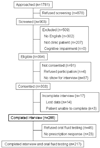A single-question screening test for drug use in primary care
- PMID: 20625025
- PMCID: PMC2911954
- DOI: 10.1001/archinternmed.2010.140
A single-question screening test for drug use in primary care
Abstract
Background: Drug use (illicit drug use and nonmedical use of prescription drugs) is common but underrecognized in primary care settings. We validated a single-question screening test for drug use and drug use disorders in primary care.
Methods: Adult patients recruited from primary care waiting rooms were asked the single screening question, "How many times in the past year have you used an illegal drug or used a prescription medication for nonmedical reasons?" A response of at least 1 time was considered positive for drug use. They were also asked the 10-item Drug Abuse Screening Test (DAST-10). The reference standard was the presence or absence of current (past year) drug use or a drug use disorder (abuse or dependence) as determined by a standardized diagnostic interview. Drug use was also determined by oral fluid testing for common drugs of abuse.
Results: Of 394 eligible primary care patients, 286 (73%) completed the interview. The single screening question was 100% sensitive (95% confidence interval [CI], 90.6%-100%) and 73.5% specific (95% CI, 67.7%-78.6%) for the detection of a drug use disorder. It was less sensitive for the detection of self-reported current drug use (92.9%; 95% CI, 86.1%-96.5%) and drug use detected by oral fluid testing or self-report (81.8%; 95% CI, 72.5%-88.5%). Test characteristics were similar to those of the DAST-10 and were affected very little by participant demographic characteristics.
Conclusion: The single screening question accurately identified drug use in this sample of primary care patients, supporting the usefulness of this brief screen in primary care.
Conflict of interest statement
The authors report no conflicts of interest.
References
-
- Saitz R, Mulvey KP, Plough A, Samet JH. Physician unawareness of serious substance abuse. Am J Drug Alcohol Abuse. 1997;23:343–354. - PubMed
-
- Yudko E, Lozhkina O, Fouts A. A comprehensive review of the psychometric properties of the Drug Abuse Screening Test. J Subst Abuse Treat. 2007;32:189–198. - PubMed
-
- WHO ASSIST Working Group. The Alcohol, Smoking and Substance Involvement Screening Test (ASSIST): development, reliability and feasibility. Addiction. 2002;97:1183–1194. - PubMed
Publication types
MeSH terms
Grants and funding
LinkOut - more resources
Full Text Sources
Other Literature Sources
Medical
Miscellaneous


